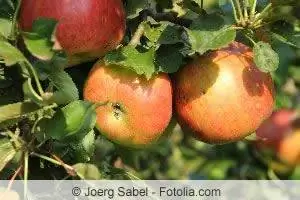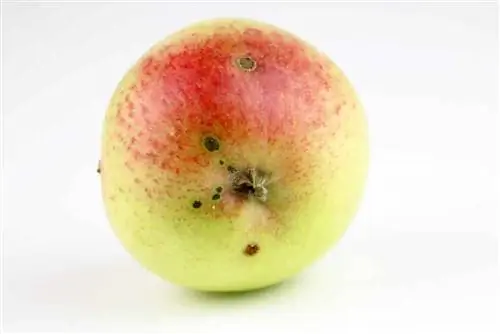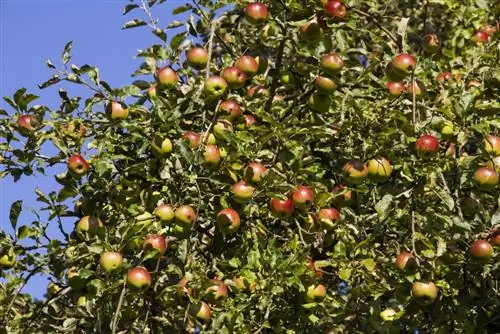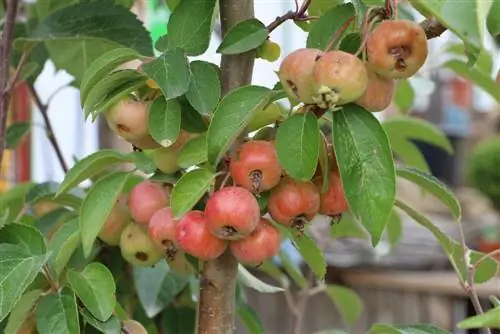- Author admin [email protected].
- Public 2023-12-17 03:39.
- Last modified 2025-01-24 12:45.
The apple sawfly belongs to the true sawfly family and is a worldwide widespread parasite that only attacks apple trees and can cause considerable damage to them. The larvae of the pest hatch inside the apples and leave spiral-shaped leaf miners on the fruit. Infected apples can usually no longer be eaten and are rejected from the tree. Ideally, an infestation is detected preventively so that the larvae cannot cause too much damage, otherwise there are some practical tools to combat them.
Appearance
The apple sawfly can be several millimeters long as an adult and has a compact body structure. The upper side of the body is black in color, while the chest area and legs are orange in color. The larvae of the apple sawfly grow up in the young apple and initially have a black head, which turns brownish with age. Due to its small size, the parasite is not initially given much attention, but this factor changes drastically when an infestation with apple sawfly larvae severely decimates the apple harvest. The following aspects should be taken into account when it comes to appearance:
- Length of apple sawfly is up to 7 mm, with 4 transparent wings
- The body shines iridescently in the sunlight
- The typical wasp waist is missing between the chest and abdomen
- Larvae measure between 9-11 mm and develop 7 abdominal legs
Dissemination
The larvae of the pest are often found in local gardens and can cause considerable damage to the fruit of apple trees. The apple sawfly spends the winter as an adult larva in a cocoon in the ground and then pupates in spring, which coincides with the apple blossom season. In summer, the larvae leave the most recently infected apples and go into the ground to overwinter. In years with heavy flowering, the appearance of the apple sawfly has beneficial effects, as the insect larvae enable natural thinning directly on the apple tree. However, if the flowering is very weak and the infestation is severe, the pest can cause extremely high crop losses and sometimes even destroy entire crops. The following criteria are crucial for distribution:
- Pupation takes approx. 17-20 days, occurs in March
- Has a saw-shaped ovipositor for laying eggs, uses it to drill a slot
- Lays about 20 eggs individually, directly into the fruit of the apple blossom
- Larvae hatch after approx. 2 weeks
- Development of the larvae takes about 3-4 weeks
- The apples are hollowed out inside and then transferred to neighboring fruits
- Larva can destroy up to five apples during its development stages
- In July-August the caterpillars leave the apples
- Overwinter at a depth of approx. 5-10 cm in the ground
malicious image
Egg-laying can be recognized early on by the cell sap that comes out, which is why the apple trees should be constantly monitored from the start of flowering. The newly hatched larvae initially mine directly under the upper skin of the fruit and then gradually hollow it out completely. On apples that have been infested for a long time, you can see holes drilled in and out with a diameter of 2-3 millimeters, from which the feces of the larvae drip out. As a rule, the affected fruits fall off the tree prematurely, but it can also happen that they remain on the tree. When it comes to the damage, pay attention to the following information:
- Danger of infestation depends on the weather conditions, the location, the flower set, the infestation pressure and the apple variety
- Oviposition slot turns brown and is clearly visible
- Leave spiral-like and corked leaf miners on young fruits
- First feeding passage is created directly under the shell and turns purple
- Emission of dank and dark feces
- Larvae normally eat their way to the nucleus
- Ripe apples have brown corking due to the feeding passages
Combat
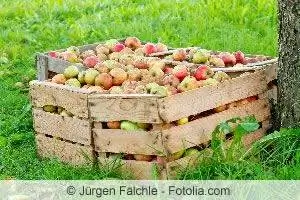
To combat the apple sawfly, specialist retailers offer various chemical agents, which often destroy other and very useful insects. However, it is better not to use these when eating the fruit later so as not to endanger your own he alth. A powerful antidote are the so-called Quassi extracts, an extract from Quassia wood, which has proven itself in organic fruit growing for regulating the apple sawfly. With this preparation, the quality of the extract and the correct time of application are extremely important, otherwise the effectiveness is enormously reduced:
- Check young apples for puncture marks from egg laying
- Remove the stamens and remove and destroy the egg laid on the base of the flower
- Apply Quasi extract shortly before egg hatching when the flowers are dying
- Wet the entire apple tree thoroughly with the extract
Tip:
Under certain circumstances, one treatment with the Quasi extract is not enough and a further 2-3 follow-up treatments must be carried out in order to completely stop the apple sawfly infestation.
Prevention
Certain procedures have proven to be effective in preventing apple sawfly infestations. Especially if an infestation occurred last year, preventive action should now be taken. White traps, which are glued before setting up and capture flying pests, are particularly suitable. The white boards simulate the blossoms of the apple trees and entice the apple sawflies to approach. The white traps should be removed about a week after the end of flowering so that other insects that are useful for the garden are not unnecessarily trapped. If apple sawflies cannot be caught during the flowering period using this method, then there will usually be no infestation by the pest this year. The following measures have proven effective in prevention:
- Perform regular tree inspections
- Approx. Set up traps a week before the apples bloom
- Hang the white traps in the outer crown area of the tree and face the sun
- The ideal installation height is approx. 1.5-2 m
- Shake off infected apples between May and June and destroy them out of reach
Tip:
The danger of the damage threshold can be calculated by the number of caught sawflies on the white board. If fewer than 20 to 30 specimens are caught before flowering, then the danger is relatively low.
Conclusion
In general, an infestation with the apple sawfly leads to a severe reduction in the harvest, as its larvae can eat their way through several fruits in their developmental stage. These can no longer be enjoyed afterwards and should be disposed of immediately if infested, ideally far away from the tree to prevent further spread. Glued white traps that are set up before and during the flowering period are particularly suitable for an initial overview of the possible risk of infestation. If an infestation has already occurred in the previous year, rapid countermeasures are essential. Quasi extracts have proven to be effective for immediate and lasting control. These ecologically compatible agents are obtained from quassia wood and are a sensible alternative to chemical pesticides that can harm human he alth. Regular inspection of the apple trees is very important so that there is enough time for the control.

